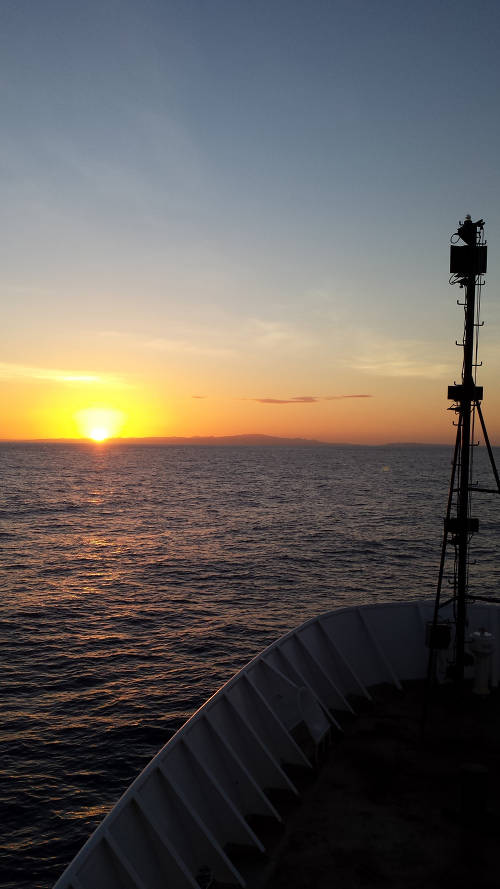
By LT Laura Gallant - NOAA Corps
April 15, 2015

LT Gallant mans the bridge during ROV recovery. Image courtesy of the NOAA Office of Ocean Exploration and Research. Download larger version (jpg, 716 KB).
2:45 am: My alarm goes off. Getting up this early is not easy, but your body eventually gets used to it.
3:10 am: After dressing and waking myself up a bit, I’m down in the darkened and deserted galley eating cereal and drinking tea (with milk and sugar please!).
3:20 am: I report to the bridge, red flashlight in hand, to start turning over the watch. The bridge is kept darkened so the lookout and officer can have good night vision to see other vessels in the area. It takes about five minutes for my eyes to adjust fully, so I walk carefully, when I first arrive I can’t even see where the officer and lookout are standing. Red light causes the least alteration to night vision, so we use red display covers and red flashlights to keep the bridge dim but still be able to read our instruments.
I plot our position on the chart; check the weather instrument readings, engine settings, course, speed, radios, and radars; and look around the horizon for visible traffic. I also read the Commanding Officer’s (CO’s) night orders, the log, the weather log, and the passdown log. Then I confer with the bridge officer to see if there is any other information I need before taking the watch.
3:30 am: I have the watch and am in command of the operation of the vessel. At this time of day, the ship is conducting night-time mapping operations. I speak with the survey lab team and make sure they are happy with the ship’s speed and end of operations time.
4:30 am: I give the marine engineer on duty his wake-up call and tell him we’ll need bow thruster capability by 5 am.
5:00 am: I bring the ship to a stop near the dive target for the day and lower the bow thruster to conduct a drift test. This helps us understand the local currents and set up for a quick remotely operated vehicle (ROV) deployment. The CO, dive supervisor, and ROV navigator usually come to the bridge at this time to observe the conditions. My lookout does the weather for me since I’m too busy manually driving the vessel.
5:20 am: The drift test is complete and I switch the ship over into Dynamic Position (DP) mode in preparation for the ROV dive. Small adjustments to ship heading and position are made.
6:15 am: The ROV navigator asks me to give the 15-minute callout for dive operations. The standby bridge officer reports to the bridge, we turn over the watch, and I grab a hard hat and head to the aft control station.
6:30 am: Control is transferred to me at the aft station, the bridge officer will stand by to monitor bridge instruments and traffic, but I now have the conn (control of the navigation of the vessel) again. The dive supervisor has us begin dive operations.
7:00 am: Deep Discoverer and Seirois are in the water and holding at 50 meters deep; it’s time to transfer control back to the bridge.
7:10 am: I take the conn back on the bridge and switch the ship into fully automatic DP. The ROV navigator gives me specific position moves to place the vessel where it needs to be for their dive target.
7:20 am: I am relieved by the incoming bridge officer.
7:30 am: Breakfast!
8:30 am: Nap time.
10:30 am: I’m awake again taking care of email and maybe watching some shows I have saved on my computer.
11:30 am: Lunch!
12:30 pm: Exercise time
1:30 pm: Time for myself, reading, watching movies, catching up on other work.
3:20 pm: I report to the bridge for my second watch of the day.
5:00 pm: I’m relieved for dinner.
5:30 pm: Back on the bridge, at this point the ROV is usually on its way to the surface and the ship is moving ahead slowly.
6:15 pm: Fifteen-minute call out for ROV recovery. The on-call officer reports to the bridge and checks the situation and heads aft to the control station.
6:30 pm: I transfer control to the officer at the aft station and remain on the bridge to monitor weather, traffic, and radios and keep the log. The mapping lead usually comes to visit me and give me the route we will be mapping for the evening. I load the route into our electronic chart display and information system (ECDIS) and plot a few of the points on the paper chart.
7:10 pm: The ROV and camera sled are back on deck and the conn is returned to me on the bridge. I start taking the ship out of DP mode and back into manual control. I then start driving towards our mapping routes for the evening and transfer the ship into autopilot mode.
7:20 pm: I’m relieved by the incoming watch.
8:00 pm: I should probably sleep, but it’s hard to get your body to sleep so early, so I’m reading or playing games on my phone.
9:00 pm: Sleep.
2:45 am: Start all over again.

Sunrise over Puerto Rico as the ship prepares for an ROV dive. Image courtesy of the NOAA Office of Ocean Exploration and Research. Download larger version (jpg, 1.5 MB).